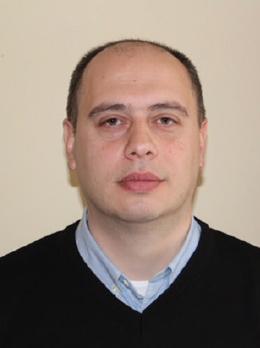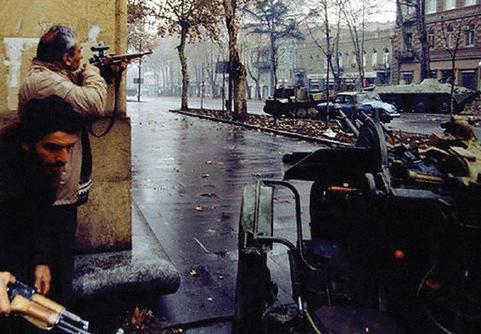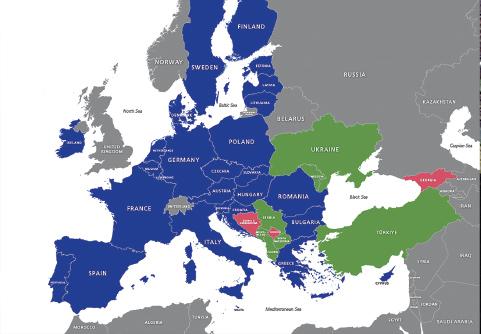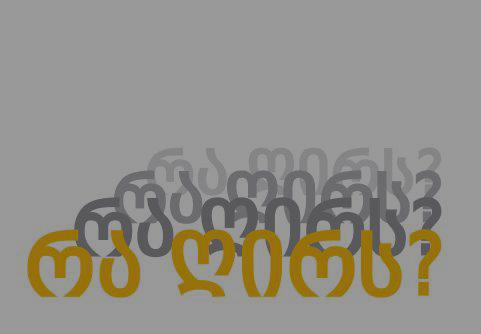Author : Gigi Gigineishvili

After the outbreak of hostilities in Abkhazia in August 1992, an informal agreement was reached between the Georgian-Abkhazian population of Tkvarcheli and units of the Georgian Guard, as a result of which Georgian military units did not enter Tkvarcheli. According to the agreement, the town was supposed to take a neutral position in the conflict, but a few days after the agreement was signed, all entrances to Tkvarcheli were destroyed and, with the active help of the Russian military, a well-organized offensive military infrastructure was set up by the Abkhaz population of the town. It later turned out that the collection of weapons and ammunition for this purpose had begun as early as 1991. Russian officers and Abkhaz separatists set up the so-called Eastern Front in the Tkvarcheli region. This was led, among others, by members of the Abkhaz organization Aidgilara: Vladimir Antsupov (a Russian officer, historian, and karate teacher living in Abkhazia) and the separatist Aslan Zantaria. They were the main perpetrators of the attack carried out against Givi Lominadze, the ethnic-Georgian Interior Minister of the Autonomous Republic of Abkhazia. They had formed a subversive group, Katran, that turned out to be both powerful and aggressive. At first, they dealt with the problems of maintaining the “defensive” (actually offensive) strip and infrastructure of the Eastern Front, and soon began systematic, ruthless attacks on villages in the nearby Ochamchire district. They deliberately burned down the houses of Georgians and ruthlessly killed the peaceful, unarmed population on ethnic grounds.
Such a situation in the rear of the hostilities created major problems at the front. However, due to the chaotic, rash and often inexplicable actions of the military and political leadership on the Georgian side, it was not possible to repel the attacks from the direction of Tkvarcheli. It should be noted that the Georgian army did not carry out air and artillery strikes because of the large number of civilians in the town. In the end, the Georgian command decided to place the Tkvarcheli area under a military blockade and, to ensure the needs of the civilian population, a humanitarian corridor was created in the direction of Gudauti from October 1992. According to the agreement, helicopters on their way to and from Tkvarcheli had to pass through the control of the Russian-Georgian Joint Commission at the Sukhumi airfield before being allowed to continue their journey. At this point, the identity of the people on board, the nature of the cargo and the general suitability of the flight for humanitarian purposes had to be verified. With this agreed order and route, over a thousand people left Tkvarcheli without any problems. It was clear, however, that such a peaceful arrangement was not in the interests of the Kremlin and the Abkhaz separatists. There were frequent flights from Gudauta to Tkvarcheli and back, bypassing the Georgian checkpoint. Russian Defense Ministry helicopters systematically delivered weapons and ammunition to Tkvarcheli, transported personnel, transferred field commanders and military trainers, and on the way back transported wounded fighters. Thus, the so-called humanitarian route was actively used to carry out combat missions. Apparently, the Georgian special services also had information about this.
After the barbaric ethnic cleansing in Gagra in October 1992, when Russian and Abkhazian mercenaries systematically killed the Georgian population of the Gagra region with unprecedented cruelty, the Georgian side realized that it was facing a merciless enemy operating without rules. Along with the pain came a legitimate thirst for revenge. Nevertheless, after the peace agreement of September 3, 1992, signed three weeks after the start of hostilities, the Georgian side effectively ceased offensive operations and concentrated on defending the areas populated by Georgians. The Russian-led separatists used the peace agreement to regroup, get better equipped, and plan offensive operations. While the Georgian side, guided by the peace agreement, ceased offensive operations, attacks from the Abkhaz side did not stop.
On December 14, 1992, at 13:00, the Russian-Abkhazian side decided to conduct another “humanitarian” flight from Gudauta to Tkvarcheli. According to the official statement, two Mi-8T helicopters of the Russian Air Force with serial numbers “02” and “03”, operated by pilots from the Russian city of Samara under the command of Aleksey Podprugin, were to transport 6 tons of flour to Tkvarcheli. In violation of the existing agreement, the Russian pilots did not pass the inspection at the Georgian checkpoint and, accompanied by two Russian Su-25s, flew directly from Gudauta to Tkvarcheli. In fact, this flight brought to Tkvarcheli the latest weapons and communications equipment, as well as Russian military personnel to coordinate the planned offensive actions.
The helicopters were supposed to return to their base in Gudauta after approximately two hours. Although they landed in Tkvarcheli in violation of the agreement, they had both the opportunity and the obligation to at least agree on the return route with the Georgian side and to submit to inspection. However, since the return route was to be used for non-humanitarian purposes, the Russian-Abkhazian side deliberately chose to violate the agreed order and route, hoping that Russian combat aviation would again ensure their safety and escort the helicopters. The Russian military pilots were well aware that on their way back they were to pick up Russian-Abkhazian fighters, including Lieutenant-Colonel Felix Bekaldiev from the Russian Federation (Chief of Staff of the Confederation of Mountain Peoples, who had arrived in Tkvarcheli a few days earlier on a specific combat mission), his accomplice Ruslan Shaov, and a captured Ukrainian spy of the Georgian Armed Forces, who was to be transferred to Gudauta at the request of the military command; as well as the above-mentioned Russian paratrooper Vladimir Antsupov and a close associate of Ardzinba, the fighter Aslan Zantaria. In total, there were up to twelve armed militants in the helicopter.
Apart from them, the besieged Tkvarcheli was full of people trying to leave the town. Both helicopters appeared to be full of women and children. Most of the passengers were from mixed Georgian-Abkhazian families. Along with armed militants, 35 children and eight pregnant women were allowed on board the helicopter. This happened in the presence of around 300 people. It is regrettable that there was not a single person in Tkvarcheli at that moment who would have stood up to the militants, forced them to leave the helicopter and not allowed them to use children and women as human shields. In that case, the helicopter would have been able to fly unhindered along the agreed route through Sukhumi, which was also safe and through which more than a thousand civilians from Tkvarcheli were transferred to Gudauta.
These methods of transportation were in most cases agreed with the separatist leaders, although it is not known whether this particular route was agreed with them or not. It should also be emphasized that Colonel A. Podprugin, together with his pilots, carried out a number of combat flights before and after the “humanitarian” flight of December 14, with aircraft #02 and aircraft #03 in this very area. After the war, he stayed in Abkhazia and settled in the house of one of the displaced Georgians.
At 17:10 on December 14, the two military helicopters took off at an altitude of 1,900 meters and headed for Gudauta, passing through an area of heavy fighting and violating the agreed route for humanitarian flights. According to the pilot, this was the so-called safe altitude, because the weapons with the longest vertical range available to the opposing sides in Abkhazia operated at a maximum of 1500 meters, but no account was taken of the fact that if a sniper climbed a mountain of 500-600 meters, he could reach an altitude of 1900 meters. According to Alexei Podprugin, the pilot of Flight #02, it was only after take-off, already in the Lata area, that he made contact with the Russian Su-25 crew, with whom he had an agreement to provide escort for the helicopters on their return.
According to the conclusion of the Investigative Commission of the Russian Air Force (the veracity of which was doubtful from the start), at 17:39 the village of Lata was shelled with Strela-2 portable anti-tank missiles from the highest point of one of the surrounding mountains.
A shell hit aircraft #03, which crashed. All the passengers were killed: children, women, old people, fighters, Russian pilots – all of them. According to different sources, between 70 and 87 people were killed.
From the first days of the tragedy, the Georgian side seemed confused. On the one hand, it was proved that the flight was not a humanitarian one from a legal point of view. But the deaths of Anzupov, Zantaria, Bekaldiyev and other fighters were completely overshadowed by the unfolding tragedy.
Since both the helicopter and its crew belonged to the Russian Armed Forces, a Russian Airborne Rescue team arrived at the crash site the next day, at the request of the Russian Ministry of Defense, inspected the site and later transported the bodies of the dead to Gudauta, already in helicopters with Red Cross markings. Later, in an attempt to evade responsibility, the Russian pilots confirmed that they had not been able to control the boarding of passengers on board helicopter #03 (as a result, the total number of passengers on board the helicopter was three times the permitted number) and that there were in fact fighters who had been boarded by decision of the Abkhazian military leadership. They also expressed dismay at the Su-25 pilots who failed to escort the flight in time and left the helicopters unattended in the most dangerous section.
Thirty years have passed since that tragic day. The Georgian side has remained silent on the issue, while the vast majority of ordinary citizens, with few exceptions, know nothing about the Lata tragedy. Under the conditions of the frozen conflict and Russian occupation, the Lata tragedy has remained essentially uninvestigated. The Russians wrote the story for the separatists, but in reality, it is still unknown who fired at the helicopter and why, whether the shooter was a representative of the Georgian side or not (perhaps it was a Russian provocation to quell the irreconcilable feelings?), or who decided to use the humanitarian flight for military purposes, to violate the agreement and change the route of the flight.
Given that the alleged shooting came from Georgian-controlled territory, the Georgian authorities at the time did not see the need to conduct a transparent investigation and implicitly took responsibility for the incident. On the other hand, the separatist government also did nothing (apart from the usual statements by Ardzinba). The reason was simple. During the days of mourning, the separatist leaders “lost control” – it was revealed that civilians were used as human shields, that the flight was not humanitarian, and that it was carried out in violation of the agreement. An objective investigation would have identified a number of criminals in their ranks.
Under these circumstances, the Russian propaganda machine and the Abkhaz separatist groups acting in unison with it took advantage of Georgia's silence to further incite hatred and hostility, spreading completely false information in Abkhaz society that the flight carrying women and children on the helicopter with special Red Cross markings was carried out by prior agreement with the Georgians and was of a purely humanitarian nature, while “bloodthirsty Georgians” deliberately shot it down and subsequently did not allow rescuers to reach the crash site.
In fact, it has been confirmed that there were no Red Cross markings on the military helicopter, that all published lists of casualties included military personnel, that the Georgian side allowed rescuers to reach the crash site, that the safe corridor was through Sukhumi and not through Lata, and that many Abkhazians from Tkvarcheli took this route safely, in accordance with the agreement, and that no one tried to attack them.
There is another alleged version, which has a right to exist, according to which, a few minutes before the helicopters took off from Tkvarcheli, the Georgian militia [SB1] received information from Tkvarcheli that wanted criminals Antsupov and Zantaria, together with other militants, would be aboard a Russian military helicopter (with reference to a specific boarding number) to fly to Gudauta. It should be noted that Antsupov and especially Zantaria also had a lot of enemies among the separatists. It is possible that it was decided in advance to get rid of them, and the Georgian side was not informed that there were women and children on board the helicopter along with the fighters. This version is supported by the fact that the only shot fired was aimed precisely at the helicopter carrying the militants (helicopter #02 landed safely in Gudauta). However, this version is based on unconfirmed information, so it is impossible to discuss it in detail at this stage.
To this day, propaganda activities related to the Lata tragedy, the main purpose of which is to incite and maintain hatred towards Georgians, are financed in Abkhazia from the Russian federal budget. Lies, hate propaganda, and inexplicable silence from the Georgian side have had their effect. Today, the Lata tragedy remains the main war trauma in Abkhazian society. Reconciliation with the Abkhazians cannot be achieved without an honest discussion of it (just as it is hard to imagine reconciliation with the Georgians without a reappraisal of the Gagra and Sukhumi ethnic cleansings and the punishment of those responsible). In these circumstances, it is surprising that, thirty years after the end of the hot phase of the war, it is still not possible to restore relations with the Abkhazians.
It is to be hoped that the time will soon come when the Georgian state, under conditions of restored territorial integrity and the return of IDPs to their homes, will investigate the terrible tragedy of Lata – along with other war crimes – determine its causes, and identify those responsible, regardless of their nationality. Let's hope that the commemoration of the innocent women and children killed near Lata on December 14, 1992 will not be limited to Sukhumi. Both Georgian and Abkhazian society need this day and its understanding to heal the wounds of war and to continue living together. In the meantime, may the souls of the innocent victims who died in Lata rest in peace!










